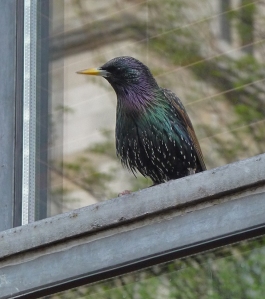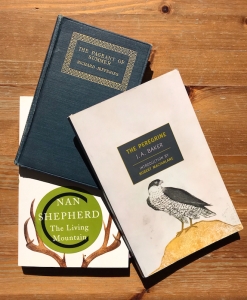Even when we can’t get out and about, nature can still help us keep well. When required to stay at, or close to home, and be socially distant, it’s important to look after your mental wellbeing.
Your wellbeing can benefit from a close relationship with nature. This ‘friendship with nature’ isn’t dependent on taking a trip into distant natural landscapes, it can be made at, or very close to home. Here are some ways everyday nature can lend a hand:
- Notice and write down the ‘Good Things in Nature’
- Explore your relationship with nature
- An audio nature meditation
- Virtual Nature – let nature help manage your emotions.
These are four nature-based suggestions to help stay well. You can try a variety of approaches to maintain your wellbeing and find ones that work for you. You can try other ideas and reach out for further support if you feel you need it.
1 – Notice and write down the ‘Good Things in Nature’
If you can see a little nature from your home, a tree, visiting birds or flowers for example, this exercise can be done each day. Simply take a moment to tune in and notice everyday nature.
You can write a sentence about the beauty of small things to the whole of the sky. It could be as simple as noticing a bird singing or the movement of a tree in the breeze. Changes in the clouds or noticing flowers bloom.
Find a friend in nature, be it the local birds or a favoured tree. If you can, take some action to encourage birds closer to your home – provide food or water for example.
2 – Use art and words to explore your relationship with nature
A close relationship with nature is good for wellbeing. And a closer relationship with nature comes through noticing nature and its beauty, feeling the joy and calm nature brings, celebrating and expressing what nature means to you, and caring for nature.
Explore and deepen your relationship with nature in ways that work for you, outside if you can, but also from home through art, music or words – be creative!
Here are 5 types of relationship with nature to get you started.
Senses– If you can, take a moment to notice any everyday nature nearby. Tune in to everyday nature through the senses. Listen to birdsong or watch the breeze in a tree.
Beauty – Notice nature’s beauty. Take time to appreciate beauty in nature and engage with it through drawing or take a photo of a flower.
Emotions– Notice how nature makes you feel – the joy and calm it can bring. Find happiness and wonder in nature, birds being active, their flight or simply a spiders’ web.
Write down and share your feelings about nature, using social media for example the #NaturalHealthService on Twitter.
Meaning– Some of the greatest works of art and favourite poems are about nature. It means a great deal to people. Find and share songs, stories, poems and art that are about nature.
For example, compile a nature playlist, try reading some classic nature writing, work that is immersed in nature such as The Pageant of Summer by Richard Jefferies available for free. Similarly, read some classic poetry about nature, such as On a Lane in Spring by John Clare, is freely available.
Explore and express how nature brings meaning to your life. Create your own songs, stories, poems and pictures of nature.
Care– Take action for nature. Think about what you can do for nature. If you can, feed the birds, plant some bee friendly flowers, dig a pond and create homes for nature.
3 – An audio nature meditation
If you don’t have access to nature, or would like to try something different, try meditating on nature.
Make sure to sit in a quiet and undisturbed place for the next 10 minutes. Check that the volume of your speaker or earphones is high enough without being too loud. This recording will guide you through a short meditation. The bell will ring at the beginning and at the end.
Settle into a comfortable position, either on a straight-backed chair, or on a soft surface on the floor. When you are ready to start, try as far as possible to adopt an erect, dignified, and comfortable posture. Allow your posture to express and support your intention to be awake and consciously present.
If sitting on a chair, have the feet flat on the floor with the legs uncrossed. If you sit on the floor, experiment with the height of the cushion or stool until you are comfortably and firmly supported, with your knees lower than your hips. Gently close your eyes as you listen:
4 – Let nature help manage your emotions.
If you can spend a little time outside in greener places, do so. If not, even viewing pictures and videos of nature can help. Take time to notice and share the good things in nature. Let nature help manage your moods and emotions.
Immerse yourself in Virtual Nature
If you can, find a spot away from distractions and use a bigger screen, to view some photos or videos of nature (try 5 or 10 minutes and see how you go), here are two examples:
If nature isn’t working for you
Try to do things you enjoy and keep your mind active. Spend time doing things you enjoy – this might include reading, indoor hobbies, listening to music, favourite radio programmes or watching TV. Play games, do crosswords or puzzles, try drawing or painting. Check out ways to get creative.
Whatever it is, find something that works for you and take time to relax.
Wider Guidance
There’s plenty of general advice available. Visit guidance from trustworthy sources, for example Every Mind Matters in the UK, for example, try to:
- Connect with others, to enjoy conversation, but also to talk about your worries if needed.
- Create a daily routine
- Plan practical things like making a plan to get household supplies.
- Try to eat healthily.
- Try to get some exercise.
- Look after your sleep.
- Don’t watch too much news – set a specific time and use trustworthy sources.
Finally, there’s also support for those finding the situation very difficult.




